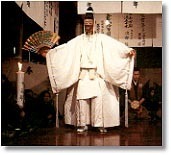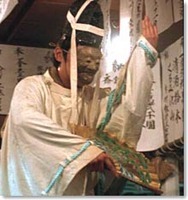

Total:35items
- Folk Performing Art (16)
- Kabuki (2)
- Noh & Kyogen (1)
- Festival (10)
- Ritual & Ceremony (2)
- Puppet Play (2)
- Folk technology (2)

 |
|
 《Feature》
《Feature》There are several theories about the origin of Kurokawa Noh. One is that Ogawanomiya, the third son of the Emperor Gokomatsu, introduced the Noh to Kurokawa, and another is that the Muto clan, who ruled Shonai Province from the 13th to 16th centuries, brought Noh players from Kyoto. The Noh has been passed down for generations over 500 years as a Shinto ritual of Kasuga Shrine, a tutelary shrine in Kurokawa.
Kurokawa Noh follows the school of Sarugaku Noh which Zeami established, and in that sense, it is the same line as the existing five schools. However, it does not belong to any school and people have handed down their original style from generation to generation. Kurokawa Noh still keeps its unique form and the old programs or interpretations which have already disappeared in the five schools.
A national important intangible folk cultural property
Provided by: Tsuruoka City Hall, Kushibiki Government Office
Translation: Tomoe Ukida, reviewed by Chan Yitin
| City/Town | Town Kurokawa district, Tsuruoka City, Yamagata Prefecture |
|---|---|
| Location | Ohgi Hall, Noh stage in the worship hall of Kasuga-jinja Shrine, etc. |
| Contact | Tsuruoka City Hall, Kushibiki Government Office (0235-57-2111) |
| Highlight/POI | There are approximately 160 Noh players for Kurokawa Noh from children to elders. It is quite a large-scale folk performing art with 230 Noh masks, 400 Noh costumes, 540 Noh plays, and 50 Kyogen plays and draws attention as an important folk performing art rooted in the life of local residents. |



